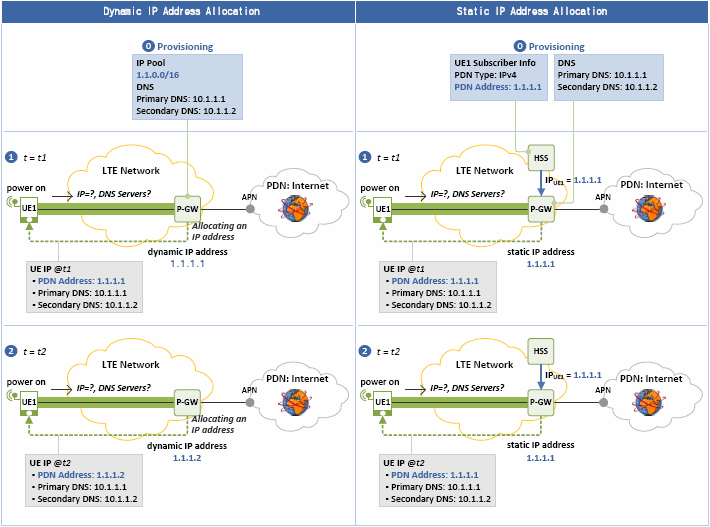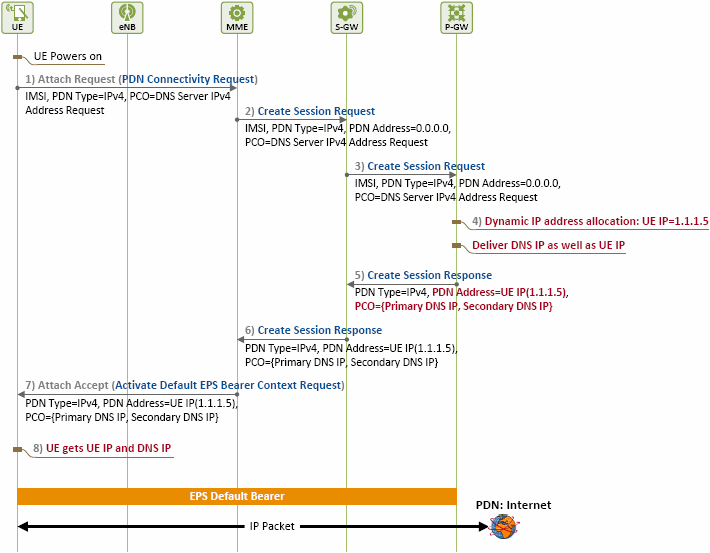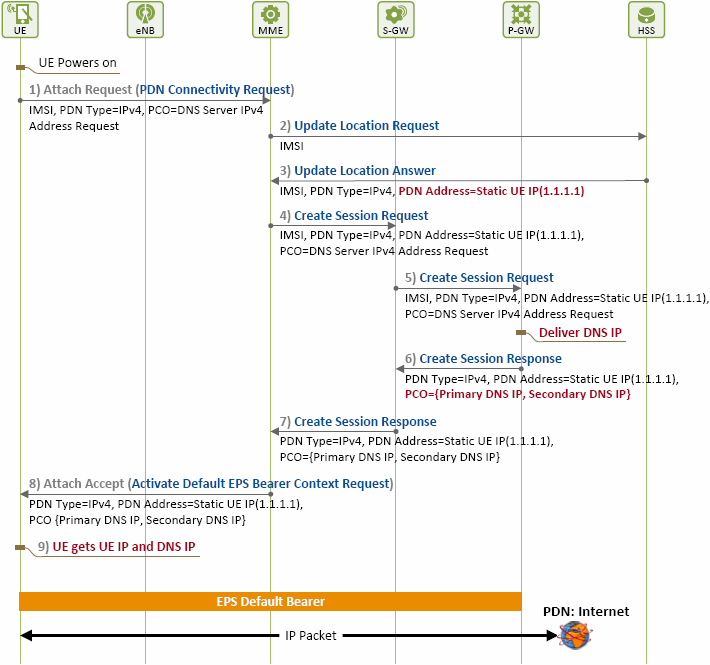SUMMARY
This document will describe how an LTE network allocates IP addresses to users accessing the network. IP addresses can be either dynamic or static depending on their allocators. Below we will discuss how the two types are different, and how they are allocated.
Table of Contents
I. Introduction
II. Types of IP Address Allocation
III. Dynamic IP Address Allocaion
IV. Static IP Address Allocation
V. Closing
I. Introduction
LTE networks are all-IP networks. This means that they deliver all user traffic in IP packets, and provide users with “always-on IP connectivity”. When UE joins an LTE network, a Packet Data Network (PDN) address (i.e. the one that can be used in the PDN) is assigned to the UE for its connection to the PDN, and a default bearer is established in the LTE network (i.e. between UE and P-GW). This default bearer remains connected (i.e. the IP address assigned to the UE during the initial attach remains valid) until the UE is detached from the LTE network.
A default bearer is established for each APN (Access Point Name)1 a user has, and thus a unique IP address is assigned for each APN. An IP address can be an IPv4, IPv6 or IPv4/IPv6 type.
This document will explain how an LTE network allocates an IP address to a user (i.e. UE) when the user initially attaches to the network, by giving an example of a case where UE uses only one PDN, the Internet, and an IPv4 type address is assigned to the UE.
Two different types of IP address allocation will be discussed in this and next documents. This document will cover the basic IP address allocation schemes and procedures, describing how IP addresses are allocated to a user who, while staying in one place, is performing initial attach to the network multiple times (e.g. by turning off UE and then back on). The next document will look into different ways of IP address allocation in case a user performs initial attach from two geographically-separated locations (e.g. City A and City B).
This document is organized as follows: In Chapter II, different types of IP address allocation – dynamic and static - and their characteristics will be discussed. Chapters III and IV will provide the detailed explanation of the dynamic and static IP address allocation procedures, respectively.
II. Types of IP Address Allocation
When UE initially attaches to an LTE network, it requests for a PDN connection. Then a P-GW allocates an IP address (i.e. PDN address) to be used by the UE for the PDN, and forwards it to the UE while a default bearer connecting the two is being established. With this IP address, the UE can use services provided through the PDN.
A P-GW allocates IP addresses in two ways: dynamic or static IP address allocation. In case of dynamic allocation, it automatically assigns an IP address every time UE accesses the network. On the other hand, in case of static allocation, it assigns a designated IP address to UE upon its subscription, and then allocates the designated IP address every time it accesses the network. Figure 1 below compares the two types.

Figure 1. IP Address Allocation Schemes
[출
In case of dynamic IP allocation, the network (e.g. P-GW) automatically selects an IP address for UE. The network operator has IP pool(s) provisioned at the P-GW in advance. Then later when UE initially attaches to the LTE network, the P-GW dynamically allocates an IP address to the UE. So, a new dynamic IP address is allocated to the same UE every time it initially attaches to the network.
However, in case of static IP allocation, the network operator allocates a permanent IP address to each UE upon their subscription to the network. The operator has an allocated static IP address provisioned for UE in the network (HSS) along with other subscription information. Then later when the UE initially attaches to the LTE network, the P-GW obtains the static IP address from HSS, and forwards it to the UE. So, this particular IP address is allocated to the UE every time it initially attaches from then on.
When requesting for a PDN connection during initial attach, UE can request for protocol data related with external protocol/application (e.g. configuration parameters) by using Protocol Configuration Options (PCO)2 parameters (e.g. request for DNS server address, P-CSCF address). This document will explain a case where DNS server addresses as well as an IP address are requested.
III. Dynamic IP Address Allocation
For dynamic allocation, the network (P-GW) keeps IP pool(s) for UEs, and dynamically allocates an IP address to UE upon its initial attach to the LTE network as seen in Figure 2 below.

Figure 2. Procedure for Dynamic IP Address Allocation
IP Provisioning at P-GW
At P-GW, an IP Pool containing IP addresses to be assigned, and DNS server IP addresses are already provisioned.

Procedure for Dynamic IP Address Allocation
A user turns on his UE, attempting initial attach to the LTE network. An explanation about general procedure for initial attach can be found in our previous technical document [2]. Here we will focus on IP address allocation only.
1) [UE → MME] Requesting for PDN (Internet) Connectivity
The UE requests for a PDN connection by sending PDN Connectivity Request (PDN type=IPv4, PCO=DNS Server IPv4 Address Request) message to MME. At this time, in addition to an IPv4 address for the UE, IP addresses for DNS servers (by PCO field) are requested as well. The PDN Connectivity Request message is an ESM message, and thus is embedded in the ESM Message Container field of Attach Request (IMSI3, ESM Message Container), an EMM message, when delivered.
2) ~ 3) [MME → S-GW → P-GW] Requesting for Session Creation
The MME, based on the subscription profile received from HSS, sends Create Session Request (IMSI, PDN Type=IPv4, PDN Address=0.0.0.0, PCO=DNS Server IPv4 Address Request) message to the P-GW for EPS session creation. As it is dynamic IP allocation, the subscription profile does not include IP address information. In the Create Session Request message, 0.0.0.0 is set for PDN Address field, and the PCO information received from the UE is included in PCO field.
4) [P-GW] Allocating PDN Address and DNS Server Addresses
The P-GW, after checking the PDN type and PDN address (0.0.0.0), knows that an IPv4 address has to be assigned. It selects an IP address (e.g. UE IP=1.1.1.5) from the IPv4 pool, and assigns it to the UE. As requested by PCO field, DNS server IP addresses are also assigned accordingly.
5) ~ 6) [MME ← S-GW ← P-GW] Responding to Create Session Request
As a response to the request made in Steps 2) and 3), the P-GW sends Create Session Response message to the MME. This message includes the UE IP address (dynamically assigned by the local P-GW) in PDN Address field, and the DNS server IP addresses (requested by user through PCO field) in PCO field.
7) [UE ← MME] Requesting for Activation of Default Bearer Context
The MME requests for activation of the default bearer context by sending UE Activate Default EPS Bearer Context Request (PDN Type=IPv4, PDN Address=UE IP(1.1.1.5), PCO={Primary DNS IP, Secondary DNS IP}) message. This ESM message contains the DNS server IP addresses as well as the UE IP address, and is embedded in Attach Accept message, an EMM message, when delivered.
8) [UE] Obtaining Dynamic IP Address for Using PDN Service
The UE obtains the dynamic IP address (1.1.1.5) and DNS server IP addresses (Primary DNS IP=10.1.1.1, Secondary DNS IP=10.1.1.2). A default bearer is established between the UE and the P-GW. The UE, now connected to a PDN (Internet), can use the Internet service with its dynamic IP address.
IV. Static IP Address Allocation
In case of static IP address allocation, the network operator assigns a UE IP address to a user when the user subscribes to the network for the first time, provisions his subscription profile at HSS, and assigns the static IP address stored in the profile every time he attempts initial attach to the network. The detailed procedure is illustrated in Figure 3.

Figure 3. Procedure for Static IP Address Allocation
[
IP Provisioning at HSS
At HSS, subscription profiles of each subscriber are provisioned. The profile includes a PDN type and a PDN address to be used for PDN connection.

IP Provisioning at P-GW
At P-GW, DNS server IP addresses have already been set.

Procedure for Static IP Address Allocation
A user turns on his UE, attempting initial attach to the LTE network.
1) [UE → MME] Requesting for PDN (Internet) Connectivity
The UE requests for a PDN connection by sending PDN Connectivity Request (PDN type=IPv4, PCO=DNS Server IPv4 Address Request) message to the MME. At this time, in addition to an IPv4 address for the UE, IP addresses for DNS servers (by PCO field) are requested as well.
2) [MME → HSS] Requesting the LTE Network for Registration
The MME informs HSS that the UE is under its (e.g. MME1) control by sending Update Location Request message, and registers the UE at the network.
3) [MME ← HSS] Forwarding Subscription Profile
The HSS, recognizing the UE is registered at MME1, forwards the UE’s subscription profile to MME1 by sending Update Location Answer (IMSI, PDN Type=IPv4, PDN Address=Static UE IP(1.1.1.1)) message. This subscription profile includes the static IP address assigned to the UE.
4) ~ 5) [MME → S-GW → P-GW] Requesting for Session Creation
After receiving the UE’s subscription profile from the HSS, the MME knows the UE has a static IP address (1.1.1.1). The MME prepares Create Session Request (IMSI, PDN Type=IPv4, PDN Address=Static UE IP(1.1.1.1), PCO=DNS Server IPv4 Address Request) message and sends it to the P-GW. At this time the message includes the static IP address received from the HSS in PDN Address field, and PCO information received from the UE in PCO field.
6) ~ 7) [MME ← S-GW ← P-GW] Responding to Create Session Request
As a response to the request made in Steps 4) and 5), the P-GW and the S-GW send Create Session Response (IMSI, PDN Type=IPv4, PDN Address=Static UE IP(1.1.1.1), PCO={Primary DNS IP, Secondary DNS IP}) message to the MME. This message includes the static IP address assigned to the UE in PDN Address field, and the DNS server IP addresses (requested by user through PCO field) in PCO field.
8) [UE ← MME] Requesting for Activation of Default Bearer Context
The MME requests for activation of the default bearer context by sending the UE Activate Default EPS Bearer Context Request (PDN Type=IPv4, PDN Address=Static UE IP(1.1.1.1), PCO={Primary DNS IP, Secondary DNS IP}) message. This ESM message contains the UE’s static IP address (1.1.1.1) as well as DNS server IP addresses, and is embedded in Attach Accept message, an EMM message, when delivered.
9) [UE] Obtaining Static IP Address for Using PDN Service
The UE obtains the static IP address (1.1.1.1) and DNS server IP addresses (Primary DNS IP=10.1.1.1, Secondary DNS IP=10.1.1.2). A default bearer has been established between the UE and the P-GW. The UE, now connected to a PDN (Internet), can use the Internet service with its static IP address.
V. Closing
So far we have discussed the two types of IP address allocation: dynamic and static. When a user attempts initial attach to the LTE network to use a PDN service (e.g. Internet, VoLTE, etc), the LTE network provides the user with PDN connectivity by allocating an IP address to be used for the PDN and a default bearer. As long as the user’s network registration is valid, the PDN address (IP address) and the default bearer are kept for the user even when he is no longer using the service. This way, the user is provided “always-on IP connectivity”.
This document has explained the scheme and procedure of IP address allocation by an LTE network when UE attempts to use a PDN service from one location, but in different times. In the next document [1], we will cover the same topics, but discuss a case where UE attempts to use a PDN service from different locations.
References
[1] Netmanias Technical Document, “LTE IP Address Allocation Schemes II: A Case for Two Cities”, February 2014 (TBD)
[2] Netmanias Technical Document, “EMM Procedure 1. Initial Attach - Part 1. Cases of Initial Attach”, December 2013
[3] NMC Consulting Group Confidential Internal Report, “E2E LTE Network Design”, August 2010
Footnotes
1. Default bearers are established for each PDN. APN is a PDN ID, and PDN information is delivered to users as APN. So, APN, more appropriate term from a user perspective, was used here.
2. See 3GPP TS 24.008 for more information about PCO.
3. If UE has a valid old GUTI, the GUTI can be used as an EPS Mobile ID.
http://blog.naver.com/PostView.nhn?blogId=netmaniascom&logNo=220282969002
[출처] [Mobile] LTE IP Address Allocation Schemes I: Basic|작성자 넷매니아즈
'Japan > 테스트 업무' 카테고리의 다른 글
| adb shell (0) | 2016.05.25 |
|---|---|
| 회선, 메시지, 패킷 교환방식 (Circuit, Message, Packet switching) (0) | 2016.05.20 |
| 모바일 네트워크 (0) | 2016.05.19 |
| Call Flow (0) | 2016.05.19 |
| qxdm references (0) | 2016.05.19 |